Solar Power and Broadcasting - Is It Viable Yet?
Paper presented to the Engineering Committee sessions of the Commonwealth Broadcasting Conference, Mauritius, November 1978.
The paper was subsequently published six months later in the CBA journal, "Combroad" and surfaced yet again in the American magazine "Broadcast Communications" in October 1979! It has been slightly abridged in the version below.
by D. W. Harris
Chief Engineer, Radio Botswana
Introduction
The past few years have seen a flurry of activity in the field of "Alternative Energy", the main impetus coming as a result of the energy crisis of the early seventies and the spin-off from the American space programme. Although in broadcasting we have naturally been interested in the development because of our involvement in society as a whole, there has been little use of solar power to date in broadcasting applications.
The particular branch of "Alternative Energy" most immediately relevant to us is of course photovoltaics. Most engineers are now aware of the basic facts about photo-electric energy conversion - for example, solar flux can exceed 1kW per square metre; maximum conversion efficiency (for silicon) is around 21 per cent; present figures are 12 per cent efficiency (rising) and $10/Watt (falling)
Low power solar-powered microwave repeaters and navigational beacons have been in operation for some years, particularly in the United States where advantage has been taken of the remote-siting possibilities to provide service to otherwise isolated areas. In broadcasting, however, we deal in kilowatts and until recently, the use of solar cells for powering anything over about 100 watts was not feasible.
This paper examines the possible use of photo-electricity for powering transmitters up to about 1kW, particularly in Botswana.
Current Technology
There is very rapid development at present in the field of solar cells but it is an indication of the maturity of the current market and research that a 350kW installation at the Blytheville, Arkansas campus of Missouri County Community College is expected to be commissioned in time for the last term of 1979. A 1 MW contract has recently been placed with the same firm (Solarex). The expected cost of electricity from the Missouri installation is around $6 to $7 per watt, obtained using sophisticated tracking and energy management systems. Battery backup is 2,4000 kWh, with conversion to AC to provide compatibility with the public electricity supply.
Looking in detail at the actual solar cells used, the last few years have seen extensive work on the edge-defined film-fed ribbon growing technique (EFG) for silicon crystal; however, the Czochralski precess of lifting a rotating "seed" crystal from a melt is still the most practical. The two methods are illustrated below: |
EFG PROCESS
The graphite die rests in a pool of molten silicon. Capillary action through a narrow slit raises the silicon to form a layer of liquid at the top of the die.
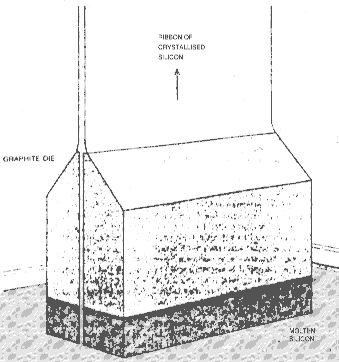
A seed crystal is drawn upward at the same rate as the crystal is growing downward so the interface between crystal and silicon remains just above the top of the die. Ribbon strip crystals grown in this way can be cut into rectangular wafers with minimum waste.These drawings with acknowledgements to "Scientific American"
|
CZOCHRALSKI METHOD
A rotating seed crystal is dipped into a crucible of molten silicon and then slowly withdrawn.
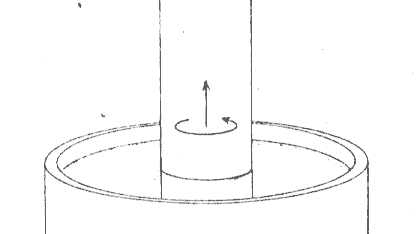
The resulting cylindrical crystal may be several feet long and 4 inches in diameter. Added boron dopes the crystal to make it p-type.
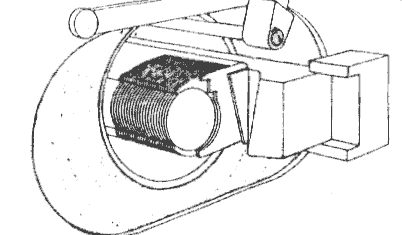
The crystal is sawn into slices - a lot is wasted in the process.
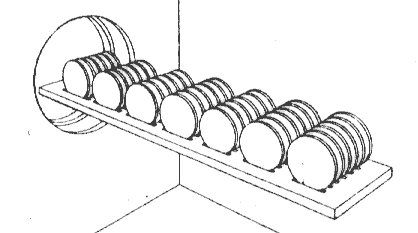
One side of the wafers is converted to n-type in an oven by exposure to phosphorus.
|
| Estimates of cost for commercial crystals grown by the EFG method are as low as £13 to £14 per square metre which is about 300 times less than the Czochralski method. Until EFG is a commercial reality, however, use will continue to be made of reflectors and other concentrators to minimise the actual cell area used. This poses other limitations, since there is a severe heat disposal problem and allowance has to be made for the apparent movement of the sun across the sky.
A number of solutions have been proposed, included Fresnel lenses, tracking parabolic mirrors and an ingeniously shaped trough known as a "Winston collector" after its inventor, Roland Winston, of Chicago University. Surplus heat can be dispersed by fluid convection to radiators or used in some more practical application.
|
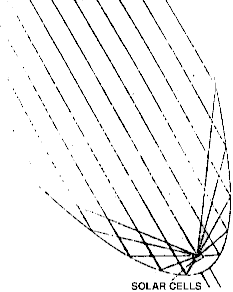
PARABOLIC REFLECTOR
|
The silvered parabolic reflector concentrates sunlight onto an array of solar cells to reduce the number of (expensive) cells needed. An automatic tracking device is required. |
| As an alternative, a fresnel lens can be used to concentrate sunlight onto the solar cell strips. No tracking is required but the concentration factor is low. |
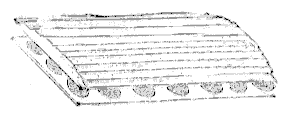
FRESNEL LENS |
WINSTON COLLECTOR
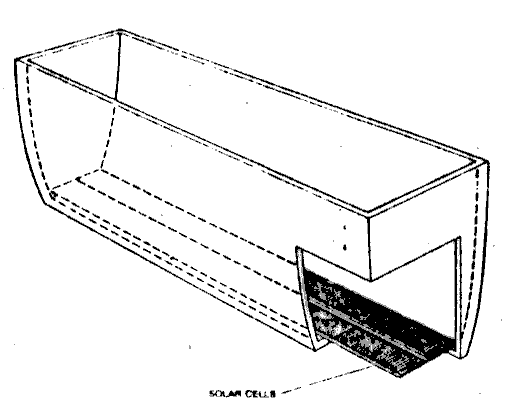
|
Shaped like a long trough, the Winston Collector concentrates sunlight onto solar cells in the bottom of the trough. It does not need to be rotated to follow the sun. |
| SOLAR CONCENTRATORS |
|
Photo-electricity in Botswana
There are compelling reasons for examining the use of photo-electricity in Botswana. Its latitude and geographical position give a high rate of insolation; there is as yet limited established infrastructure with its associated pressures to conform to existing technology; and the cost of electricity is reputedly the highest in the world at approximately 8 pence or 14¢ per unit. Without criticising the power supply authority, reliability of supply to the necessarily isolated transmitter sites is mediocre in broadcasting terms, if only because of the prevalence of lightning in the country (Botswana is among the top five nations worst affected by electrical storms).
Before examining the financial implications, it is worth noting some facts about Botswana. Radio Botswana is currently planning a major expansion of broadcast coverage which, amongst other things, may well involve dual-purpose use of comparatively low-power VHF/FM transmitters. These would provide FM coverage of a town or large village and feed into a high gain aerial for programme feed to the next transmitter in the chain. Power may or may not be available locally, and the transmitter would be located a short way out of town on the nearest convenient high ground. The station would be unattended but a travelling team from the capital, Gaborone, would take responsibility for maintenance.
Some typical price levels in Botswana are:
| 11 kV power feed (overhead) per kilometre: | £2,325
|
| 11 kV power feed (underground) per kilometre: | £3,255
|
| Sub-station for above, 5 kVA: | £ 581
|
| Auto-reclose switch for power trips: | £ 698
|
| Electricity charge per kWh (approx:) | £ 0.065
|
Sunshine and solar radiation figures in Botswana are such that even on days with little or no sunshine the level of solar radiation is on average at least 20 per cent of the absolute maximum - thus battery reserve can be limited to about 100 hours or thereabouts. A 12 volt 100 Ah battery costs about £23.
Radio Botswana has been quoted approximately £14,000 for a solar power system based on the Solarex Photovoltaic Concentrator System of 650 Watts. This includes tracking control equipment.
Armed with these figures then, let us consider some practical situations:
| CASE ONE: |
| Conventional power installation using overhead 11kV feed. Auto-reclose must be provided for security of supply in case of lightning strikes. The transmitter runs 300 watts output. Total electrical loading including P.I.E., mast lighting, etc., is about 1kW. Assume a power line run of 7 kilometres. | |
| Power line installation: 7 km x £2,325 | £16,275 | |
| Transformer: | £ 581 | |
| Auto-reclose switch: | £ 698 | |
| Total for installation, Case One | £17,554 | |
| Power charges, assuming 5 years' operation, 18 hours per day | £ 2,196 | |
| TOTAL COST OVER FIVE YEARS (Approx.) | £19,750 | |
| | | |
| CASE TWO: |
|---|
`
| Underground power installation; otherwise as Case One; auto reclose probably not necessary. | |
| Power line installation: 7 km x £3,255 | £22,785 |
|
| Transformer: | £ 581 |
|
| Total for installation, Case Two | £23,366 |
|
| Power charges, as above: | £ 2,196 |
|
| TOTAL COST OVER FIVE YEARS (Approx.) | £25,562 | |
| | | |
| CASE THREE: |
|---|
| Solar installation as quoted above, with 100 hours battery reserve. Cost of solar installation calculated pro-rata, although in practice a slight saving would occur due to non-duplication of control equipment. | |
| Solar installation: | £21,470 | |
| Battery back-up: | £ 1,940 | |
| Total for installation, Case Three | £23,410 | |
| Power charges: | NIL | |
| TOTAL COST OVER FIVE YEARS (Approx.) | £23,410 | |
Comments
The figures speak for themselves. Obviously the main trade-off for the use of solar power is against power line installation costs, and the local conditions would affect the economics. In this article it is not possible to discuss the merits of one or other solar installation, but the advantages of immunity from lightning failure, possibilities of installation in otherwise remote locations and even electricity supply costs apply to all solar projects.
There are of course other considerations. Broadcasting engineers are by nature conservative and the technology is so new in the solar energy field that it is not difficult to justify caution. Such considerations as loss of efficiency due to dust on the collectors, reliability of tracking systems and so on would obviously be taken into account. Against this, however, must be placed the excellent record of solarpowered space craft and the continuing decrease in prices as the technology moves out of the laboratory into the commercial field.
Extrapolation of the figures given above for progressively higher electrical loads is not difficult; the breakeven point for a one kilowatt transmitter, for example, would occur for a power-line feed distance of about 15 to 20 kilometres.
The use of solar power for broadcast transmitters around the 300 to 1000 watt range is economically feasible, the capital cost of the solar panels being offset by power-line installation costs. Reliability would depend on the manufacturer of the solar installation.
APPENDIX: SOLAREX PHOTOVOLTAIC CONCENTRATOR SYSTEMS
For medium to large-scale photovoltaic power generation systems, linear parabolic trough reflectors which track the sun are used to concentrate sunlight onto strings of photovoltaic cells.
Flat photovoltaic generators have successfully been used since 1957. Reliability, efficiency and power ratings have improved continuousiy and rapidly. As the scope for new applications widens, so the demand for more power increases. There is a practical and economical limit to the vast areas of photovoltaic surface that would be required to meet higher power applications, and as photovoltaic cells are relatively costly, it is logical to use simple mirrors to perform the function of collecting and concentrating sunlight. The output of the cells is determined by two factors: their area and the intensity of insolation impinging upon them.
Frame and Base Assembly
The parabolic trough collectors are mounted on a rectangular frame constructed from aluminium extrusions in which they rotate. Elevating sliding racks support this frame on the horizontal structural base. The reflective trough collectors and the receiver tubes to which the photovoltaic cells are bonded are constructed as single rigid units. Mirror focal lengths and rim angles are chosen for optimum performance.
An economic minimum is four troughs per frame, generating 1.4 kW peak electrical power.
Parabolic Troughs
Each trough measures 1.l metre wide by 3.2 metres long overall, comprising a total of 12 mirror segments, 6 to a side. These are constructed of 3.2mm glass with a silver layer deposited on the back followed by a protective coating. The mirrors exhibit an average reflectivity index of 95 per cent in the vital 400 nm to 700 nm range of the solar spectrum. Highly accurate focussing is achieved. The mirrors are resistant to ultra-violet degradation and surface abrasion. Padded mounting slots support the mirrors and allow for thermal expansion and contraction. Wind loadings of 120 km/hr have been experienced with no ill effects.
Receiver Design
The receiver tubes serve the purpose of rigidly supporting the cells facing the linear focus of the parabolic troughs and maintaining the cells at an optimal maximum temperature of 55 deg C.
The receivers are rectangular stainless steel tubes through which coolant is circulated. The rectangular solar cells are bonded to these by a technique allowing good electrical insulation yet good heat transfer. Developed for operation under higher solar concentrations, the adhesive compounds are thermally conductive and electrically insulating. Mounted 1 mm apart, strings of cells are interconnected from the top of one cell to the bottom of the adjacent cell by redundant tinned OFHC copper interconnects with stress loops compensating for the thermal cycling. The receivers are subjected to more severe thermal stresses than any other component in the system.
Concentrator Cell Design
Designing a concentrator cell involves a detailed analysis of the cell efficiency as a function of cell substrate resistivity, thickness, sheet resistance of the diffused layer, concentration ratio, geometry, cell size and electrode design to achieve the maximum possible power output.
The particular cells for these systems are 40 mm wide and 60 mm long in active area for operation in 20x to 25x concentrations. These cells are fabricated using singlecrystal, p-type boron doped (100) oriented silicon wafers.
The n+ region is created by gaseous phosphorus diffusion, with the back surface field created by aluminium alloy. Both front and back contacts are formed by palladium passivated "Trimet" metallization techniques. The front surface bus bar pattern is applied by photolithographic methods, essential to high performance cells. The bulk of the current-carrying metallization is applied by electroplating silver to the required thickness. Solarex's patented tantalum oxide anti-reflective coating provides superior optical matching with the overcoating and encapsulants, thus yielding greater cell efficiency. At 55 deg C and 22x average concentration their efficiency is 13 to 14 per cent.
Tracking Systems
East-West (Azimuth) tracking is accomplished by sliding rack gears along the rectangular frame at the top and bottom ends of the troughs. These rotate 150 mm diameter Delrin gears mounted on both ends of the troughs. For North-South (Elevation) tracking, the whole frame assembly, pivoted about its lower end, is raised and lowered by slides on support shafts hinged at their lower ends. One geared motor drives the rack gears and another the elevation slides.
Electronic Tracking Control
Accurate guidance and control of the array orientation in relation to the sun is essential to peak performance. The sun sensor basically comprises two plates normal to each other with small matched cells on either side of both plates, each plate controlling each axis tracked. When either plate is not absolutely perpendicular to the sun, the shadow cast on one side of the plate causes a reduction in the output of the solar cell on that side. A bridge type comparator circuit provides a signal which drives the array to equalise the output of the cells. The entire sensor unit is hermetically sealed in a glass bulb.
Electrical and Thermal Performance
Total system performance efficiency is 11 per cent. Each trough has a collector aperture of 3.23 sq m. In standard insolation each trough output will be 350 W at 28 V nominal. Other voltages can be made available. Each trough can be coupled in series or parallel. For a four trough system of 1.4 kW electrical output the peak thermal energy output is approximately 9 kW of which between 100 W and 400 W thermal energy will be lost by convection by the receivers.
Return to Commonwealth Broadcasting Association . . .
Botswana index . . .






